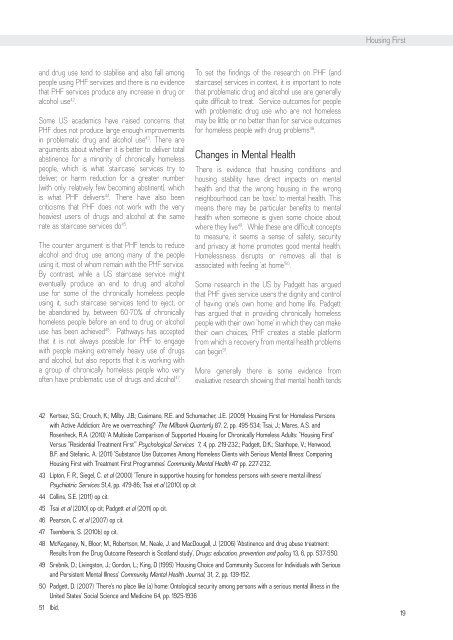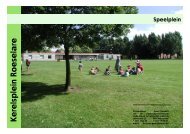Housing First - Provincie West-Vlaanderen
Housing First - Provincie West-Vlaanderen
Housing First - Provincie West-Vlaanderen
You also want an ePaper? Increase the reach of your titles
YUMPU automatically turns print PDFs into web optimized ePapers that Google loves.
<strong>Housing</strong> <strong>First</strong>and drug use tend to stabilise and also fall amongpeople using PHF services and there is no evidencethat PHF services produce any increase in drug oralcohol use 42 .Some US academics have raised concerns thatPHF does not produce large enough improvementsin problematic drug and alcohol use 43 . There arearguments about whether it is better to deliver totalabstinence for a minority of chronically homelesspeople, which is what ‘staircase’ services try todeliver, or harm reduction for a greater number(with only relatively few becoming abstinent), whichis what PHF delivers 44 . There have also beencriticisms that PHF does not work with the veryheaviest users of drugs and alcohol at the samerate as staircase services do 45 .The counter argument is that PHF tends to reducealcohol and drug use among many of the peopleusing it, most of whom remain with the PHF service.By contrast, while a US staircase service mighteventually produce an end to drug and alcoholuse for some of the chronically homeless peopleusing it, such staircase services tend to eject, orbe abandoned by, between 60-70% of chronicallyhomeless people before an end to drug or alcoholuse has been achieved 46 . Pathways has acceptedthat it is not always possible for PHF to engagewith people making extremely heavy use of drugsand alcohol, but also reports that it is working witha group of chronically homeless people who veryoften have problematic use of drugs and alcohol 47 .To set the findings of the research on PHF (andstaircase) services in context, it is important to notethat problematic drug and alcohol use are generallyquite difficult to treat. Service outcomes for peoplewith problematic drug use who are not homelessmay be little or no better than for service outcomesfor homeless people with drug problems 48 .Changes in Mental HealthThere is evidence that housing conditions andhousing stability have direct impacts on mentalhealth and that the wrong housing in the wrongneighbourhood can be ‘toxic’ to mental health. Thismeans there may be particular benefits to mentalhealth when someone is given some choice aboutwhere they live 49 . While these are difficult conceptsto measure, it seems a sense of safety, securityand privacy at home promotes good mental health.Homelessness disrupts or removes all that isassociated with feeling ‘at home’ 50 .Some research in the US by Padgett has arguedthat PHF gives service users the dignity and controlof having one’s own home and home life. Padgetthas argued that in providing chronically homelesspeople with their own ‘home’ in which they can maketheir own choices, PHF creates a stable platformfrom which a recovery from mental health problemscan begin 51 .More generally there is some evidence fromevaluative research showing that mental health tends42 Kertsez, S.G.; Crouch, K.; Milby. J.B.; Cusimano, R.E. and Schumacher, J.E. (2009) ‘<strong>Housing</strong> <strong>First</strong> for Homeless Personswith Active Addiction: Are we overreaching?’ The Milbank Quarterly 87, 2, pp. 495-534; Tsai, J.; Mares, A.S. andRosenheck, R.A. (2010) ‘A Multisite Comparison of Supported <strong>Housing</strong> for Chronically Homeless Adults: “<strong>Housing</strong> <strong>First</strong>”Versus “Residential Treatment <strong>First</strong>”’ Psychological Services 7, 4, pp. 219-232.; Padgett, D.K.; Stanhope, V.; Henwood,B.F. and Stefanic, A. (2011) ‘Substance Use Outcomes Among Homeless Clients with Serious Mental Illness: Comparing<strong>Housing</strong> <strong>First</strong> with Treatment <strong>First</strong> Programmes’ Community Mental Health 47 pp. 227-232.43 Lipton, F. R., Siegel, C. et al (2000) ‘Tenure in supportive housing for homeless persons with severe mental illness’Psychiatric Services 51,4, pp. 479-86; Tsai et al (2010) op cit44 Collins, S.E. (2011) op cit.45 Tsai et al (2010) op cit; Padgett et al (2011) op cit.46 Pearson, C. et al (2007) op cit.47 Tsemberis, S. (2010b) op cit.48 McKeganey, N., Bloor, M., Robertson, M., Neale, J. and MacDougall, J. (2006) ‘Abstinence and drug abuse treatment:Results from the Drug Outcome Research is Scotland study’, Drugs: education, prevention and policy 13, 6, pp. 537-550.49 Srebnik, D.; Livingston, J.; Gordon, L.; King, D (1995) ‘<strong>Housing</strong> Choice and Community Success for Individuals with Seriousand Persistent Mental Illness’ Community Mental Health Journal, 31, 2, pp. 139-152.50 Padgett, D. (2007) ‘There’s no place like (a) home: Ontological security among persons with a serious mental illness in theUnited States’ Social Science and Medicine 64, pp. 1925-193651 Ibid.19
















